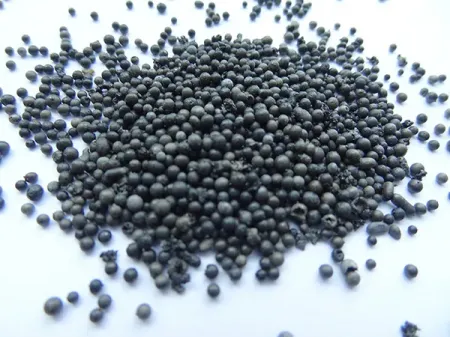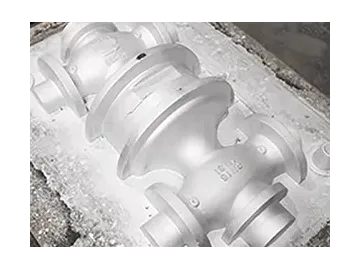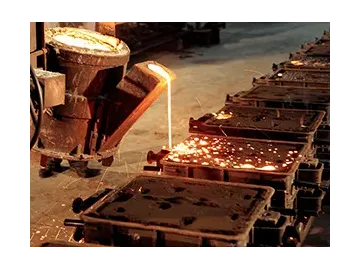Ceramic Foundry Sand
Request a Quote
Ceramic Foundry Sand
Ceramic foundry sand is made from high-quality calcined bauxite, processed through electric fusion, granulation, and screening processes to produce spherical refractory particles.
Applications
- Mainly used in casting processes such as shell molding, precision casting, lost foam casting, heavy steel casting, resin coated sand casting, vacuum casting, and investment casting.
- Steel ladle drainage agent (replacing chromite foundry sand) - high pouring rate, low specific gravity, low thermal expansion rate.
- Alloy surface treatment (replacing glass beads) - Moderate hardness, good wear resistance, stable chemical composition.
- Refractory coatings (replacing zirconium powder or alumina powder) - High refractoriness, low thermal expansion coefficient, good permeability, low cost.
Features
- Spherical grain shape with excellent flow ability and easy compaction. Smooth surface, dense structure, low surface area, requiring less binder and curing agent. It has high compactness, preventing metal liquid infiltration and mechanical sand penetration.
- High refractoriness and good chemical stability at high temperatures. It is a neutral material, resistant to corrosion by metal compounds, preventing chemical sand sticking.
- Low thermal expansion rate effectively prevents the gradual formation of expansion defects.
- Good resistance to breakage, minimal dust generation, environmentally friendly, and recyclable, reducing costs and conserving resources.
Typical Chemical Analysis
| Chemical Composition | Al2O3 | SiO2 | Fe2O3 | TiO2 | CaO | MgO | K2O | Na2O |
| Content | 70-75% | 8-20% | ≤ 3% | ≤ 3.5% | ≤ 0.45% | ≤ 0.35% | ≤ 0.33% | ≤ 0.08% |
Typical Physical Properties
| Shape | Spherical | Refractoriness | ≥ 1800℃ |
| Color | Dark Brown | Thermal Expansion | 0.13% |
| Bulk Density | 1.95 -2.05g /cm | Thermal Conductivity | 0.698W/M.K |
| True Density | 3.4g /cm | Angularity | ≤1.1 |
Particle Size Distribution
| Mesh | μm | 1700 | 850 | 600 | 425 | 300 | 212 | 150 | 106 | 75 | 53 |
| spec | 10 | 20 | 30 | 40 | 50 | 70 | 100 | 140 | 200 | 270 | |
| 20-40 | ≤2 | 15-40 | 30-55 | 15-35 | ≤3 | ||||||
| 30-50 | ≤10 | 25-45 | 35-55 | 5-15 | ≤5 | ≤2 | |||||
| 40-70 | ≤10 | 25-45 | 20-40 | 5-25 | ≤7 | ≤5 | |||||
| 40-100 | ≤3 | 10-25 | 25-40 | 25-45 | 10-25 | ≤10 | ≤5 | ||||
| 50-100 | ≤10 | 10-30 | 30-50 | 15-35 | ≤15 | ≤5 | ≤2 | ||||
| 50-140 | ≤8 | 10-25 | 20-45 | 20-45 | 5-20 | ≤7 | ≤2 | ||||
| 70-140 | ≤10 | 10-25 | 25-45 | 15-35 | ≤15 | ≤5 | |||||
| 100-200 | ≤3 | 10-35 | 35-55 | 15-35 | ≤10 | ||||||
| 100-270 | ≤2 | 5-20 | 30-50 | 25-45 | 5-20 | ||||||
| 140-270 | ≤5 | 5-25 | 40-60 | 25-40 | |||||||
| 200-270 | ≤5 | 35-55 | 25-45 | 25 | |||||||
(other sizes are customizable)
Production Flow
- Ceramic Foundry Sand Processing
- Bauxite smelting
- Electric fusion sand making
- Screening
- Sampling
- Testing
- Packaging
FAQs
The refractoriness of ceramic foundry sand refers to its ability to maintain its physical and chemical properties under high temperatures. As a refractory material, ceramic foundry sand needs to withstand various thermal stresses, chemical erosion, and mechanical stresses under high temperature conditions to ensure its service life and stability.
a. Refractoriness test method:
The refractoriness test is conducted by placing the ceramic foundry sand sample under high temperature conditions and gradually heating it until significant sticking, cracking, or loss of physical and chemical properties occurs in the sample.
b. Refractoriness test standards:
Common international refractoriness test standards for ceramic foundry sand include ISO, ASTM, etc. Domestic standards include GB, JC, etc.




